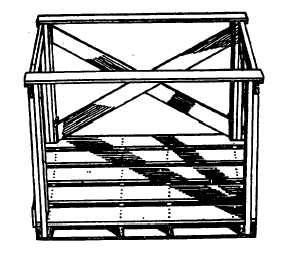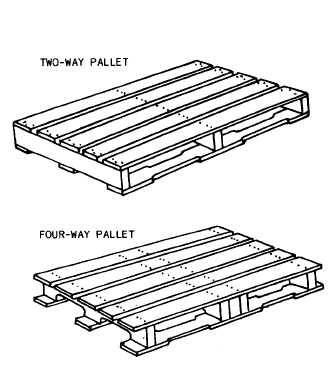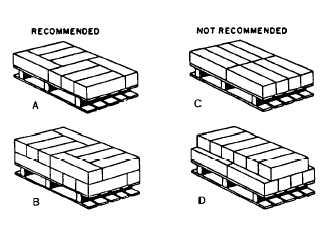| |
The advantages to using material-handling
equipment are quite noteworthy. It speeds up the
availability of material and reduces the amount
of manpower required. It accomplishes this by
large single movements of stock, which simplifies
the stowing and shipping of material with the use
of less people. Handling materials in this fashion
also reduces the risk of damage to materials and
reduces personnel fatigue and injuries.
Pallets
A pallet is a low, portable platform built of
wood, metal, or fiberboard, built to specified
dimensions, on which supplies are loaded, trans-
ported, or stored in units. Flat pallets are either
single-faced or double-faced. Single-faced pallets
have one platform with stringers underneath on
which the weight of the load rests. Double-faced
pallets have two platforms separated by stringers.
Pallets may afford two-way or four-way entry.
The two-way entry pallet is built so the forks of
a forklift truck may be inserted from either the
front or rear of the pallet. The four-way pallet
is built so the forks of a forklift truck may be
inserted from any of the four sides. Both of these
pallets are shown in figure 4-2. The box pallet
shown in figure 4-3 is used primarily for handling
small lot items or easily crushed material.
Figure 4-3.—Box pallet.
When loading a pallet, three things must be
considered: (1) maximum load, (2) stability, and
(3) proper pallet size. Make sure the pallet will
pass through all doors, aisles, and hatches likely
to be encountered. The stability of the material
on the pallet must be considered and a decision
made as to the type of pallet to use, platform or
box pallet.
Figure 4-4 shows the recommended and not
recommended ways to load material on a pallet.
Since the size of the boxes being loaded will
determine their arrangement on the pallet, a
standard loading pattern is not always appro-
priate. However, in the illustration you can see
that the material not only fits the pallet (in
recommended A and B stacking), but they are
arranged to provide stability against slipping and
sliding. Boxes of materials are not always the same
Figure 4-2.—Two-way and four-way pallets.
Figure 4-4.—Loading pallets (views A, B, C, and D).
4-7
|



